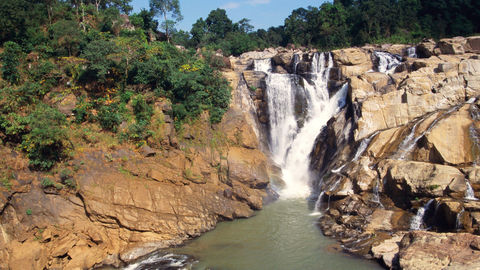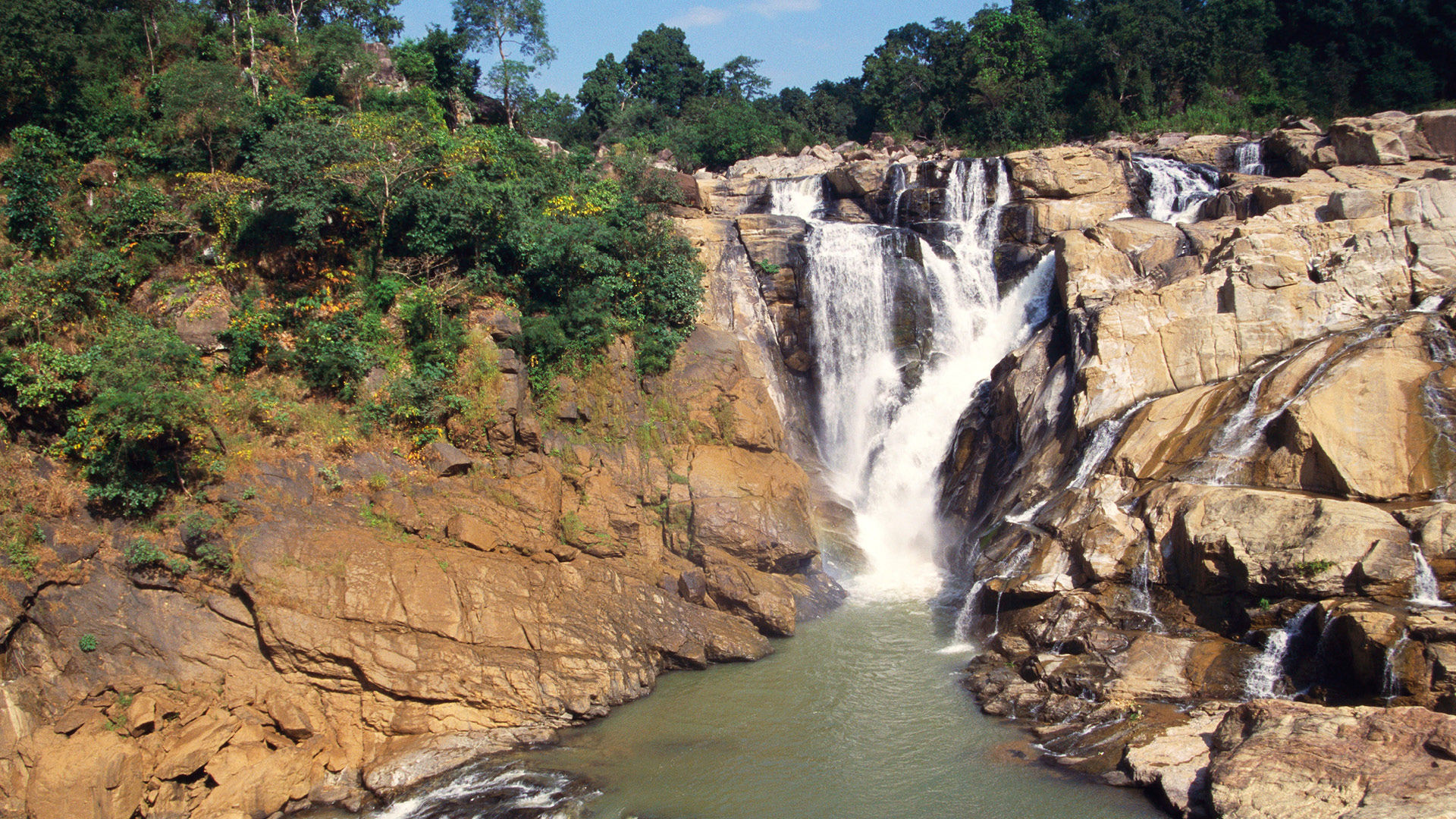
Whether you’re exploring the state capital Ranchi or the Steel City of Jamshedpur, you’re never far from splendid nature, warm people, a dash of history, and good food while in Jharkhand. By Anubhuti Krishna

I first spot it from the flight, shining bright in the autumn sun, peeking from the dense jungles and rocky hills. The massive mass of frothy water plays hide and seek for a while, before completely disappearing behind the velvety canopy of trees. By now, I am looking at other interesting things— tiny settlements with colourful roofs, snaking rivers glistening in the sun, and fluorescent fields spread like carpets. Landing in Ranchi is a treat for the eyes.
Located in the heart of Jharkhand, Ranchi stands on the edge of one of the world’s oldest landforms—the Chota Nagpur Plateau. Surrounded by dense jungles, corralled by rocky hills, and inhabited by cheerful people, the city was once a celebrated holiday destination, where sahibs and aristocrats came to escape the heat and humidity of Calcutta (now Kolkata) and Patna. Owing to its climate, it doubled up as the summer capital
of Bihar, a state it was a part of until it became the permanent capital of Jharkhand in 2000.

The term ‘Jharkhand’ translates to ‘the land of jungles’, and it is easy to see why. Even though the state is an important contributor to India’s economy and industry, 30 per cent of its area is covered by forests. No sooner than you exit the city, the jungles start surrounding you. And it is these forests that hide in their lush green bosom the many frothy waterfalls of Ranchi.
“No one goes to Dassam Falls at this time of the year!” declares our friend and guide, Subhasis, who has volunteered to show us around Ranchi. We had told him about our sighting from the air and requested him to take us to the falls. “There won’t be a soul around, what’s the point?” he protests. What he doesn’t realise perhaps, is that it is this very emptiness of these places that attracts us city dwellers.
The waterfalls in and around Ranchi have been the identity of the city for almost a century. Luckily, even in the times of unchecked tourism, they have somehow evaded the eye of tourists. And so, none of the major waterfalls located at a stone’s throw from the capital get much traffic. Dassam is no different.
We drive off the highway through a narrow road, snaking through miles of paddy fields. Small villages—each a handful of cottages—pass by. Baby goats drift on to the roads; little kids run alongside the car. The only traffic we encounter is a bicycle and a flock of hens. Short rocky hills call out to us from the horizon, and the cool breeze and fluffy clouds set the tone for the day.

It is impossible to believe that a water body of such magnitude and beauty can be so close to habitation, and yet remain hidden from the outside world. When we finally arrive at the falls, there is actually no one there. A steep flight of stairs gets us to a strategic viewing point. The waterfall, which had been playing peek-a-boo until now, reveals itself in its full glory. The water in spate is muddy due to the ongoing rains, which lend it a beautiful beige tint. The straight 144-foot drop has created a huge cloud of mist. The fall spreads out in a semi-circle around us, forming pools of water underneath. Even as we stand transfixed, trying to absorb the scale of the falls, listening to its roar echoing against the quietness of the surrounding foliage, and feeling overwhelmed by the wonder of nature, we see a few young boys gathered around the pool.
We leave Dassam reluctantly, but are excited about the other falls that await us—Hundru, Johna, Hirni, and Panchghagh. Each of them turns out to be as exquisite as the other, but none of them come with the trappings of a crowded tourist place.
If Ranchi is the waterfall capital of Jharkhand, Jamshedpur is its cultural cousin. Home to two rivers, Subarnarekha and Kharkai, protected by the lush Dalma hills, and bedecked by the picturesque Dimna Lake, the 100-year-old city is also home to Asia’s oldest steel factory and multiple mining townships, which lend it the epithet of Steel City.
The three-hour drive from Ranchi to Jamshedpur is replete with views of paddy fields and mountains. Seasonal lakes spring up next to the road, patches of forests appear at turns, and countless little villages, untouched by the vices of the modern world, make for a picture-postcard setting. We stop at a settlement along the newly-built state highway and indulge in piping hot samosas, tea, and Jharkhand’s special sweet—pantua.

Our exploration of Jamshedpur begins from its most popular spot, Jubilee Park. A gift to the city from the Tatas on its 50th anniversary, the sprawling park stretches over 200 hectares in the heart of town. Designed on the lines of the Brindavan Gardens of Mysuru in Karnataka, and Shalimar Bagh and Nishat Bagh in Kashmir, it is where the city descends every morning and evening for fresh air. I come across a copper bust of the founder of Jamshedpur—Jamsetji Tata. It overlooks the park, and seemingly the well-being of its people.
A walk in Jubilee Park must be followed by a dosa in Jamshedpur. We are now at Madrasi Hotel, the city’s oldest restaurant and the best place to sample a dosa. Set in a quiet lane off the city’s main road, Madrasi Hotel was founded by a young man in 1935 on the behest of the Tata Steel company itself (the city was new and had no place for migrant workers to eat). And so, for 90 years now, Madrasi (as the locals call it) has earnestly carried on the responsibility of feeding the citizens—an achievement it wears lightly. We are generously fed their special ghee butter cheese dosa with thick chutney, and regaled with stories from the restaurant’s long history.

For a 100-year-old town, Jamshedpur has a fair share of history, of which its contribution to World War II is most interesting. During the war, when the British could not manufacture enough tanks of their own, Tatanagar came to their rescue. The first vehicle to drive out of Tata Steel was a tank called Tatanagar. The nearby jungles served as a base for the American and English Air Forces, and the city made special arrangements for their boarding by setting up an entire hotel. Today, you may not be able to see Tatanagars roaming around town, but chairs from the Second World War era are still used in its cafes, the hotel still exists, and the earliest beams made in the factory proudly hold together the roof of the city’s only Parsi restaurant, Café Regal.
As we stroll through Jamshedpur’s clean, organised streets, the city reveals other interesting aspects—wide avenues, lined with large trees, cut each other at right angles; huge art deco bungalows are neatly placed along the periphery of public parks; places of worship belonging to every faith are fairly distributed across the town; marketplaces with thatched roofs and small shops dot every neighbourhood; and two large stadiums grace the humble skyline.
Jamshedpur’s most significant icon, however, remains the steel factory— indispensable to the city and its history. It is this steel factory, Tata Steel, that had turned a dense jungle into a bustling town back in 1919. Trains filled with men had arrived from all over India in
search of livelihood, and the small tribal village of Sakchi, where the factory was set up, became an important point on India’s map.

There is a lot more to Jamshedpur than its history, architecture, and layout. On one side, you have a series of mining townships; on the other, you have nature and wildlife reserves.“Do you see those hills? That is where we are going now,” we are still in Jamshedpur, driving along the mesmerising River Subarnarekha, when our friend Subhashis points to a range of hills in the horizon. With low clouds drifting by, mist emanating from the river, and the hills right in front of us, the scene could have belonged to any exotic destination in the world. But this place is here, now, in the heart of Jharkhand, and somehow, I am not surprised.
Getting There
Ranchi’s Birsa Munda Airport is about seven km away from the city centre, and is connected to major Indian cities. Jamshedpur is a scenic three-hour drive from the state capital.
Stay
Radisson Blu Ranchi offers sweeping views of the city, with all modern amenities and easy access to important sites (starts from INR 5,000/ USD 70; radissonhotels.com).
Dalmanchal in Jamshedpur offers splendid views of the jungles and hills. It grows and cooks its own organic produce and has multiple boarding options (starts from INR 2,000/ USD 28; dalmanchal.com).
When
September to March.
Ideal For
Nature and wildlife lovers, food and culture enthusiasts.
Discover
Tusu Parab is a local harvest festival celebrated by the tribes of Jharkhand every January. Women sing special songs and worship the sun. The festivities last for weeks with fairs, feasts, and special programmes. Offsetting the huge, dark boulders of the Gonda hills in Ranchi is the huge reservoir of the Kanke Dam. This lake is great for fishing and makes a perfect picnic spot.
Related: Here’s Why You Need To Explore The Wonders Of Jharkhand This Year










